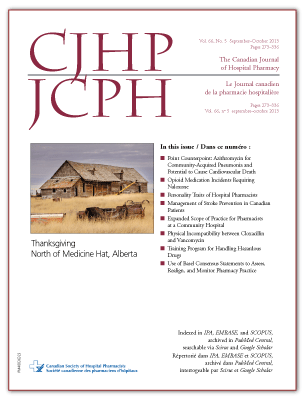Management of Stroke Prevention in Canadian Patients with Atrial Fibrillation at Moderate to High Risk of Stroke
DOI:
https://doi.org/10.4212/cjhp.v66i5.1286Keywords:
atrial fibrillation, stroke, warfarin, management, fibrillation auriculaire, accident vasculaire cérébral, warfarine, prise en chargeAbstract
ABSTRACT
Background: Many patients with atrial fibrillation who are at moderate to high risk of stroke do not receive anticoagulation with vitamin K antagonists (VKAs) in accordance with recommendations.
Objective: To determine (1) why Canadian patients with atrial fibrillation who are potentially eligible for VKA do not receive this therapy, (2) why Canadian primary care physicians discontinue VKA therapy, and (3) why VKA therapy is perceived as difficult to manage.
Methods: The study involved a chart review of 3 cohorts of patients with nonvalvular atrial fibrillation at moderate to high risk of stroke: patients who had never received VKA treatment (VKA-naive), those whose treatment had been discontinued, and those whose VKA treatment was considered difficult to manage.
Results: Charts for 187 patients (mean age 78.4 years, standard deviation 8.9 years) treated at 39 primary care sites were reviewed (62 treatment-naive, 42 with therapy discontinued, and 83 whose therapy was considered difficult to manage). Atrial fibrillation was paroxysmal in 82 (44%) of the patients, persistent in 47 patients (25%), and permanent in 58 (31%). One patient in each of the 3 cohorts had experienced a stroke during the 6 months before study participation. Bleeding events were more frequent among patients who had discontinued VKA therapy than in the other 2 groups. Among those whose therapy was discontinued and those whose therapy was difficult to manage, the mean time in the therapeutic range was 46.3% and 56.4%, respectively. The most common reason for not initiating VKA therapy in treatment-naive patients was the transient nature of atrial fibrillation (25/62 [40%]). The most common reason for discontinuation of VKA therapy was a bleeding event (10/42 [24%]). The presence of a concomitant chronic disease was the most common reason that a patient’s therapy was considered difficult to manage (46/83 [55%]).
Conclusions: VKA therapy was not initiated or was discontinued for various reasons. Multiple comorbid conditions made management of VKA therapy more difficult. These findings reflect the challenges that primary care physicians experience in managing the care of patients with atrial fibrillation.
RÉSUMÉ
Contexte : De nombreux patients atteints d’une fibrillation auriculaire (FA) et présentant un risque d’accident vasculaire cérébral (AVC) modéré ou élevé ne reçoivent pas d’anticoagulothérapie par un antagoniste de la vitamine K, conformément aux recommandations.
Objectif : Déterminer 1) pourquoi les patients canadiens atteints d’une FA et qui sont des candidats potentiels à l’anticoagulothérapie par un antagoniste de la vitamine K ne reçoivent pas ce traitement, 2) pourquoi les médecins canadiens de soins primaires interrompent l’anticoagulothérapie par un antagoniste de la vitamine K, et 3) pourquoi la prise en charge d’un tel traitement est considérée comme difficile.
Méthodes: Cette étude comportait une analyse des dossiers médicaux des patients de trois cohortes atteints d’une FA non valvulaire et considérés comme présentant un risque modéré ou élevé d’AVC : patients qui n’avaient jamais reçu d’anticoagulothérapie par un antagoniste de la vitamine K, patients chez qui ce traitement avait été interrompu et patients chez qui la prise en charge de ce traitement était considérée comme difficile.
Résultats : Les dossiers médicaux de 187 patients (âge moyen de 78,4 ans, écart-type de 8,9 ans) traités dans 39 établissements de soins primaires ont été analysés (62 : jamais traités, 42 : traitement interrompu et 83 : prise en charge considérée comme difficile). On a répertorié 82 (44 %) cas de FA paroxystique, 47 (25 %) cas de FA persistante et 58 (31 %) cas de FA permanente. Un patient dans chacune des trois cohortes a eu un AVC durant les six mois précédant sa participation à cette étude. Les saignements étaient plus fréquents parmi les patients chez qui on avait interrompu le traitement par l’antagoniste de la vitamine K que chez ceux des deux autres groupes. Parmi les patients chez qui le traitement avait été interrompu ou sa prise en charge était considérée comme difficile, le temps moyen dans l’écart thérapeutique était respectivement de 46,3 % et de 56,4 %. La raison la plus souvent évoquée pour ne pas instaurer le traitement par un antagoniste de la vitamine K chez les patients n’ayant jamais reçu un tel traitement était la nature passagère de la FA (25/62 [40 %]). La raison la plus souvent évoquée pour interrompre ce traitement était les saignements (10/42 [24%]). La présence d’une comorbidité chronique était la raison la plus souvent évoquée pour expliquer la prise en charge difficile de ce traitement (46/83 [55 %]).
Conclusions : L’anticoagulothérapie par un antagoniste de la vitamine K n’était pas instaurée ou était interrompue pour diverses raisons. La présence de multiples comorbidités rendait sa prise en charge plus difficile. Ces résultats reflètent les difficultés des médecins de soins primaires dans la prise en charge des patients atteints de fibrillation auriculaire.
Downloads
Published
Issue
Section
License
After publication of a manuscript in the CJHP, the authors of the manuscript must obtain written permission from the CSHP (publications@cshp.ca) before reproducing any text, figures, tables, or illustrations from the work in future works of their own. If a submitted manuscript is declined for publication in the CJHP, all said rights shall revert to the authors. Please note that any forms (e.g., preprinted orders and patient intake forms) used by a specific hospital or other health care facility and included as illustrative material with a manuscript are exempt from this copyright transfer. The CJHP will require a letter from the hospital or health care facility granting permission to publish the document(s).
Copyright © Canadian Society of Hospital Pharmacists.









